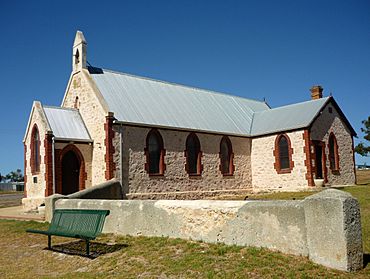Raukkan, South Australia facts for kids
Quick facts for kids RaukkanNarrung, South Australia |
|
|---|---|

Raukkan Church, 2015
|
|
| Population | 96 (2021 census) |
| Location |
|
| LGA(s) | The Coorong District Council |
| State electorate(s) | MacKillop |
| Federal Division(s) | Barker |
Raukkan is a special place for Australian Aboriginal people. It is a community located on the shore of Lake Alexandrina. This is about 80 kilometers southeast of Adelaide, the capital city of South Australia. Raukkan is seen as the "home and heartland" for the Ngarrindjeri people.
This community was first set up as a mission in 1859. It was called Point McLeay back then. Later, in 1916, it became an Aboriginal reserve. The land was given back to the Ngarrindjeri people in 1974. In 1982, its name was changed to Raukkan.
Contents
Raukkan's History
Raukkan means "meeting place" in the Ngarrindjeri language. For thousands of years, it was a very important gathering spot. Different Ngarrindjeri "lakalinyeri" (clans or family groups) would meet here. It was also where the Grand Tendi met. This was like the parliament or main council for the Ngarrindjeri people.
Early Encounters and the Mission
The English explorer Charles Sturt visited Raukkan a long time ago. The Ngarrindjeri people living there helped Sturt and his group. They gave them food when they were hungry.
In 1859, a group called the Aborigines' Friends' Association started a mission here. They called it "Point McLeay." The goal was to help the local Aboriginal people. They built a school, a church, and other buildings. However, farming was hard because the soil was not good. Also, nearby farms made it harder for people to hunt.
Voting Rights and World War I
Something amazing happened in 1896. Aboriginal men and women at Raukkan were allowed to vote! They voted in state and federal elections. This included the first election for the Parliament of Australia in 1901. More than 100 Aboriginal people from Raukkan were able to vote.
During World War I, many men from Raukkan joined the army. They were among the first Aboriginal men from South Australia to enlist. Sixteen men from Raukkan volunteered. Four of them, Alban Varcoe, Millar Mack, and brothers Cyril and Rufus Rigney, did not come home. A special window in the Raukkan church remembers them.
Changes and Self-Management
In 1916, the government took over running Raukkan. It became an Aboriginal reserve. This change was based on ideas from a government report. This report suggested that the government should look after Aboriginal children.
Since 1974, the Ngarrindjeri people have managed their own community. They renamed it Raukkan in 1982. Today, the Raukkan Aboriginal School is still in the town. In 2021, the population was 96 people. All of them identified as Aboriginal and Torres Strait Islander people.
Raukkan Aboriginal School
The school in Raukkan was started by the Ngarrindjeri people and a missionary named George Taplin. This happened between 1859 and 1860. In 2010, the school celebrated its 150th birthday! In 2018, the school had 15 students, all of whom were Ngarrindjeri.
Famous People from Raukkan
Raukkan has been home to many important people.
- James Unaipon (born around 1835) was the first Australian Aboriginal deacon. A deacon is a church leader.
- His son, David Unaipon (1872–1967), was a famous writer and inventor. He is so important that his picture is on the Australian fifty-dollar note! The Raukkan Church is also on the note.
- Ivaritji (born around 1849) was a Kaurna elder. She was the last known person to speak the Kaurna language.
- Harry Hewitt (born around 1861) was a great athlete. He played football for big teams like Port Adelaide.
- Roland Carter (1892–1960) was the first Ngarrindjeri man from Raukkan to join the army in World War I. He was even a prisoner of war.
- Annie Isabel Rankine (1917–1972) was the first leader of the Raukkan community council.
- Leila Rankine (1932–1993) was a community worker and musician. She helped start a music center for Aboriginal studies.
- Doreen Kartinyeri (1935–2007) was a Ngarrindjeri elder and historian. She helped share the history of her people.
- Kysaiah Pickett (born 2001) is a professional Australian Rules footballer. He plays for the Melbourne Demons Football Club.


